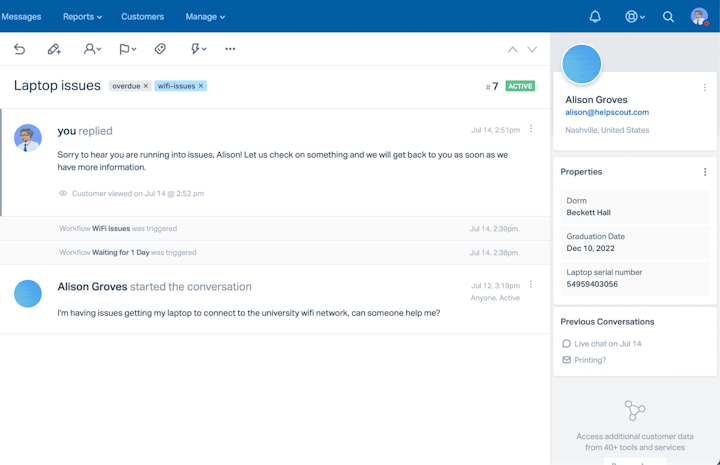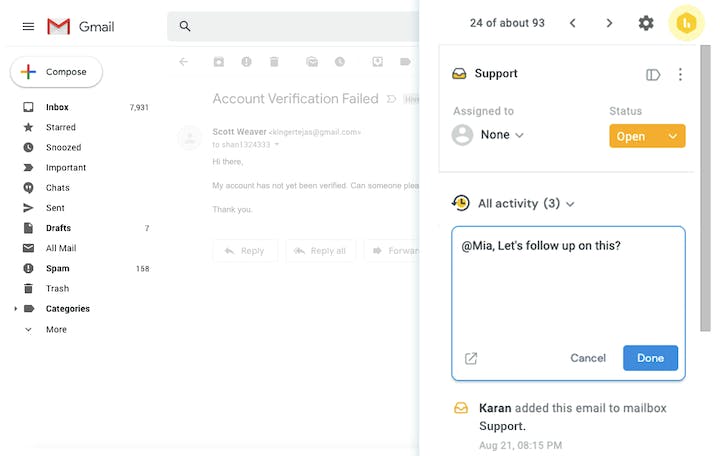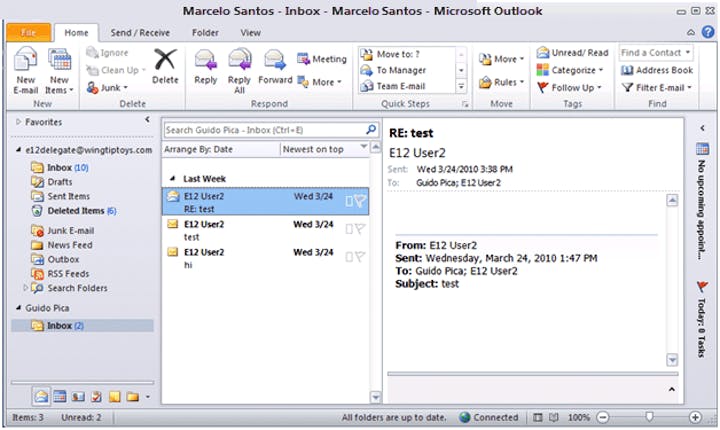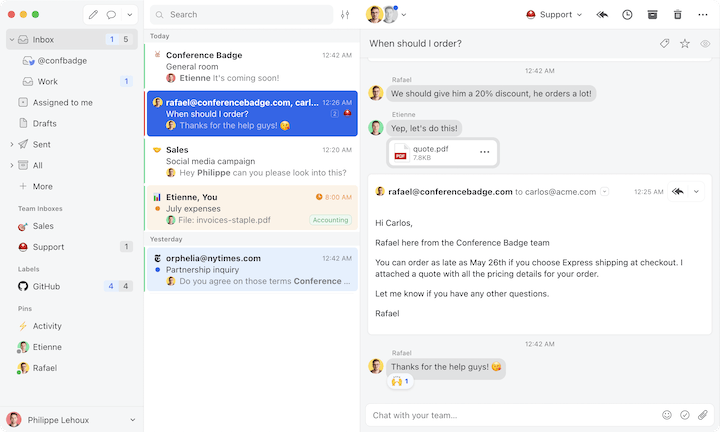The 9 Best Team Email Management Software for 2023


There are many advantages to email: It’s easy to use, simple to implement, affordable to manage, and accessible to (nearly) everyone. Shared email gives teams one simple channel for solving a stream of issues.
However, it's notoriously difficult to wrangle a shared Gmail or Outlook mailbox. Emails slip through the cracks, teams accidentally send out multiple responses, and everyone lacks the context they need to solve ongoing problems.
The best team email management software magnifies the strengths of email while also solving some of the problems caused by a shared mailbox, improving team collaboration, and optimizing the customer experience.
The 9 best team email management software
In order to create a great experience through email, you need access to the right tools. Since email management is a pretty broad category, we put together a list of eight team email management tools that cover a number of different use cases.
Help Scout
Hiver
Emailigistics
Front
Microsoft Shared Mailbox
eDesk
HubSpot
Helpwise
Missive
1. Help Scout
Best all-around team email management software.
Help Scout is team email management software built specifically to help teams easily use email to communicate with their intended audience, be they customers, potential clients, students, or even members of other departments within their organization. With Help Scout you get access to powerful collaboration tools that keep everyone informed and eliminate duplicate work.
Stay organized as you scale with mailboxes, tags, and assignments
Help Scout's mailboxes, tags, and assignments can help your team keep things organized:
Mailboxes: Mailboxes sort email messages across teams, brands, products, and email accounts, which is especially helpful if your team is responsible for multiple email addresses.
Tags: Categorize emails by topic or type of issue with tags. These visual indicators help you track different conversations — and they enable topic-specific reporting, too.
Assignments: Assign conversations to users through a simple drop-down menu. The user sees all of their assignments in a “mine” folder. You can also search by an assignee to see what a specific team member is working on during any given day.
Automate routine tasks with workflows
Instead of manually organizing your email queue, you can set up automated workflows to assign requests to the appropriate team members, prioritize urgent requests, move requests to different folders, and more.
For example, you could create a workflow that checks the body text for the word “payments” and have requests including that term automatically sent to your billing team. These workflows free up your team to focus on helping humans rather than powering through an administrative slog.
Collect feedback with satisfaction ratings
Help Scout offers the option to include satisfaction surveys at the end of each email your team sends. You can adjust the language and visuals in emails and on the collection page. There’s also the option of including a space for comments.
With this capability, you benefit from capturing the real thoughts and feelings of the people you communicate with every day.
Bring efficiency to the queue with context
Customer profiles in Help Scout's sidebar show you previous conversations between your team and an email’s sender, as well as other basic information to help interactions go smoothly and limit hassle for both your staff and the people they assist.

To pull in more information, teams can leverage integrations or a custom app built through Help Scout’s API. With each data point, you have more context for a response that addresses the needs of the person sending you an email, no matter the circumstance.
Collaborate behind the scenes with notes, saved replies, and collision detection
With Help Scout, you can tag colleagues in notes that are only viewable by internal team members. There’s no toggling back and forth between different tools and no chance someone outside of your team can see your notes.
Team members can also create saved replies for routine requests. That way, they’re not starting from scratch every time they respond to an email, they have a template — saving time for employees and helping them provide quicker responses.
You can also see who is responding in real-time to avoid collisions or repeat responses; simple red and yellow markers show who is responding to a conversation. Even if you miss those signals, collision detection prevents team members from sending out an email to someone who already received a response.

Best of all, email management software is just one of the entire suite of support tools you get access to when signing up for Help Scout. A couple other notable tools are Docs, which allows you to build out a knowledge base, and Beacon, which lets you provide live chat and send proactive messages.
Price: Starting at $20/user per month.
Learn more about Help Scout:
2. Hiver
Best team email management software for Gmail users.

Many of the tools on this list are standalone offerings, but Hiver is a little different. Basically, it acts as an extension to an existing Gmail account. You’re able to assign emails to specific employees and add notes — all things you can’t do from a standard Gmail account.
There are also task automation and analytics features, but it should be noted that many of the more advanced features are only offered on their higher-cost plans.
Price: Starting at $12/user per month.
3. Emailigistics
Best team email management software for Outlook users.

Emailigistics is similar to Hiver, but instead of working with Gmail, it’s an overlay for Outlook. It provides similar functionality and light collaboration features such as notes and assigning capabilities.
You’re also able to do some automation like routing team emails to specific people based on certain conditions to improve productivity and response times. Rounding things out, they offer access to analytics to see how your team is performing, though this is only offered on their higher-cost plan.
Price: Starting at $10/user per month.
4. Front
Best team email management software for combining personal and team email.

Email management software is often used to manage a group email address (i.e., info@companyname.com). However, if your team wants to respond to both personal and team emails, Front could be a great option since you can use both group and personal email addresses.
Front offers some collaborative features like internal comments, and they also have more advanced features like analytics and workflow automation on their higher-cost plans.
Price: Starting at $19/person per month.
5. Outlook Shared Mailbox
Best free team email management software.

People using Microsoft Outlook are able to create shared mailboxes that multiple team members can access. Basically, you create the team email address, then invite others in your organization to give them access.
The primary benefit of using a shared mailbox is you're able to give multiple people access to one inbox. If you're a small team of two people, that don't handle a ton of email requests, then it might be a good solution. However, if you need any expanded collaboration or efficiency tools, it probably won't hit the mark.
Price: Free for Outlook users.
6. eDesk
Best team email management software for ecommerce.

eDesk is email management software with a focus on ecommerce teams. They have a number of integrations that let you connect with sites like Shopify, eBay, and Amazon. Instead of looking at multiple channels, you’re able to have all those messages in one central inbox.
You’re also able to process refunds and returns for eBay orders directly from eDesk, which can be a huge time saver if you do a lot of business on that platform. Beyond that, eDesk offers some more standard features like internal notes, reports, and collision detection – though some of those are only offered on their higher-cost plans.
Price: Starting at $69/agent per month.
7. HubSpot Service Hub
Best team email management software for teams using HubSpot CRM.

HubSpot is best known for their CRM tool, but they also offer an email management tool called Service Hub. It offers basic functionality like email sorting, assignment capabilities, and the ability to add internal notes.
As a standalone tool, there isn’t much differentiating it from other entries on the list. That said, if you use HubSpot CRM, you’re able to directly integrate customer profiles, giving additional context to your conversations.
Price: Free plan available. Paid plans starting at $45/month.
8. Helpwise
Best team email management software for social media.

Helpwise is a shared inbox tool that covers an impressive number of channels. It offers basic features like internal notes and email assignments, and it includes collision detection to help reduce duplicate replies and save time for your team.
You’re also able to automate routine tasks like team email assignments and give quick answers to standard questions using saved replies. However, both of those features do have limits on their base plan, which could be a hindrance for some teams.
Price: Starting at $20/user per month.
9. Missive
Best team email management software for project management teams.

Missive is somewhat of a blend of two tools: email and project management. You have the expected functionality of other email management software, like email sorting and assigning, as well some basic automations and reporting capabilities.
Along with that, you’re also able to create and assign tasks to different users. One quirk of Missive is that their base paid plan has a six-month history limit (the free plan has a 15-day history limit), meaning you can’t see any team emails more than six months old.
Price: Free plan available. Paid plans starting at $13/user per month.
What is team email management software?
Team email management software is a tool that helps teams manage, sort, organize, and send email. Team email management tools are mainly focused on incoming emails — one-to-one interactions — instead of sending emails to large lists of people.
Even though they are one-to-one interactions, people generally use the types of email management solutions we cover in this article for group email accounts where multiple users have access. A common example of this would be a contact@companyname.com or support@companyname.com email address.
How do group email accounts work?
A group email account functions very similarly to a personal email account. Messages come into an inbox, then you’re able to respond from there. The key difference with group email accounts is that multiple people have access and can respond to requests instead of just one person having access.
For security reasons and data tracking, most of the time each user has an individual login for the group email account. Depending on the email management software you use, you may be able to set up personal email queues where users can manage the messages they’ve responded to directly. Though those messages are still accessible by others with access to the group email account.
Tips for choosing the best team email management software
Knowing which options are available and the key features to look for is a great starting point when searching for email management software. But it’s only a start; in order to find the best fit for your team, you’ll need to take a few more steps.
Involve your team in the process
The best people to help you select a team email management system are your team members. They’re the ones with their hands on the wheel every day, and leaving them out sets a bad precedent.
If you select a system that doesn’t align with known pain points, your team members are a lot less likely to go all-in on the change.
Approach the selection process as a leadership opportunity for at least one full-time individual contributor and one manager. This small group will play an important role in shaping the team’s approach moving forward; make sure they’re excited about the chance to contribute to positive change.
Understand the weaknesses of your current system
Send out a survey to your team asking where your current system is failing to meet your organization's needs. Make sure to go through any big-picture takeaways from their responses as a group to make sure you understand their greatest insights.
Here are some possible questions to explore:
What do people complain about most?
If someone writes in with an ongoing issue, what’s your process for understanding past communications?
Are you happy with the current email response time?
Do you know how many issues you resolve every day?
Do you have the permission and capability to turn around a bad experience (give refunds, etc.)?
How do you measure your own performance every day?
If you could change one thing about the current email management process, what would it be?
How often does someone write in saying an issue still hasn’t been resolved?
All of these details set the foundation for you to understand how a new tool can fit in within the larger context of your email support strategy.
Think beyond how you use the tool today
Beyond the team and recipient experience, you’ll also want to consider how email management software can help your larger organization better align with its values and empower leadership with compelling business insights.
When you’re considering different options, think big, and imagine how a team email management tool could transform your organization from the top down.
Test solutions that align with your needs
Using the key priorities your team has already identified, narrow down the list of potential email management solutions to a handful of options.
From there, set aside time to test them all. Ask the team members you appointed to use the software the way they would every day. Run reports, create saved replies, assign conversations to team members, and respond to emails, noticing how the sender's history appears within the software.
As simple as it is to select the software with the most bells and whistles, take the time to hone in on the options that make it easiest to serve your audience’s needs while aligning with your organization's values.
Most of all, consider the solution that has the same level of support that you aspire to provide. Reach out to their support team often and see how well it works on their end; if they don’t live up to your expectations, their software won’t either.
Improve your support experience
When teams struggle to stay on top of emails, your community can tell. Rather than let the fluctuating state of your inbox dictate the experience of your organization, invest in a team email management tool that ensures people receive the help they need every day. Your team members will be happier, and the people you support will be too.
The Supportive Weekly: A newsletter for people who want to deliver exceptional customer service.






